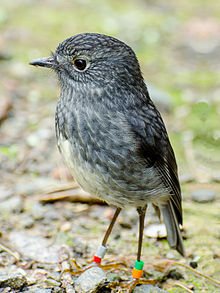North Island robin
| North Island robin | |
|---|---|
 |
|
| Scientific classification | |
| Kingdom: | Animalia |
| Phylum: | Chordata |
| Class: | Aves |
| Order: | Passeriformes |
| Family: | Petroicidae |
| Genus: | Petroica |
| Species: | P. longipes |
| Binomial name | |
|
Petroica longipes Garnot, 1827 |
|
The North Island robin (Petroica longipes) is a species of Australasian robin endemic to the North Island of New Zealand. It and the South Island robin of South and Stewart Islands were once considered conspecific (and called the New Zealand robin), but sequences have shown that the two lineages split prior to the and supported the split into two species. The North Island robin is distributed mostly in the centre of North Island, with small relict populations in the north and south in Moturua Island in the Bay of Islands, Little Barrier Island and Kapiti Island. Populations have been reestablished in Karori Wildlife Sanctuary and Moehau in the Coromandel Peninsula. A remnant population is also reestablishing itself in the Ohope Scenic Reserve in the Bay of Plenty. 40 birds have also been translocated from Mokoia Island, Lake Rotorua, to the Ohope Scenic Reserve to assist in the re-establishment of the species. Their natural habitat is mostly natural forest, particularly Podocarpus and Nothofagus forests, from sea level up to the tree line.
The plumage is dark grey-black overall with a pale area on the belly and breast (which is smaller than that of the South Island robin) and pale streaking on the upperparts. They are sexually dimorphic, with males having darker plumage than the females and being slightly larger.
The North Island robin, like the South Island robin, is a terrestrial feeder foraging on or near the ground (unlike the related and more arboreal tomtit). Prey items are located by perch-hunting, where an individual waits at an elevated perch until prey is spotted, or by active searching; prey is taken from the leaf-litter, low vegetation (branches and foliage) and tree trunks. Numerous invertebrate prey is taken, including cicadas, earthworms, wetas, snails, and spiders. Fruit is also taken. North Island robins cache food supplies for later when prey is plentiful, although males cache more food than females do. Both sexes will steal food from their mate's cache, and are less likely to cache food if their mate is present.
...
Wikipedia

